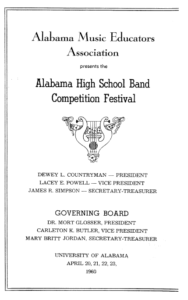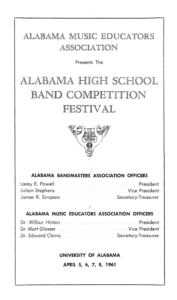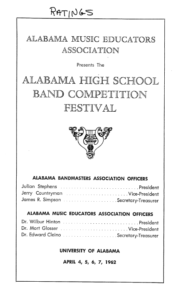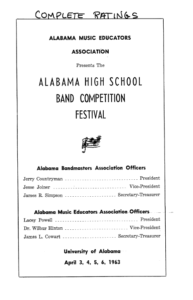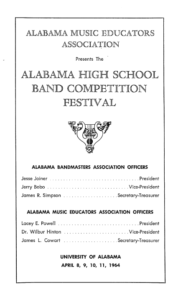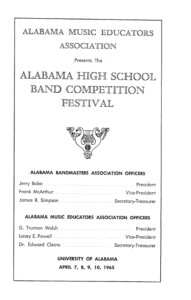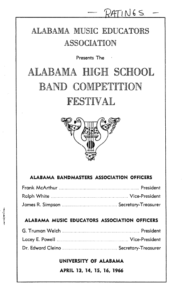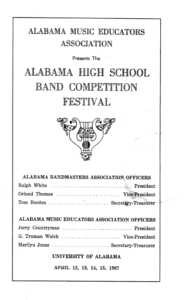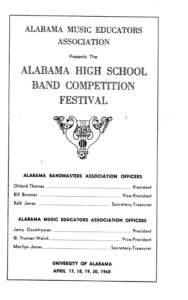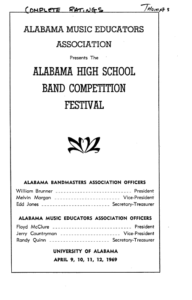1940‘s – 1950‘s – 1960‘s – 1970‘s – 1980‘s – 1990‘s – 2000‘s – 2010‘s – 2020‘s
The 1960s saw a time when the first baby boomers were playing in school bands across Alabama. School enrollments were growing. Band programs were growing in size and quality. While officially called a “competition-festival,” it was usually referred to as “State Contest,” a term used to this day by those who were involved with bands at that time. Enjoy reading about this part of the history of Alabama’s school band movement and the members of the Phi Beta Mu Hall of Fame who helped shape it.
Click the year or the program cover to open a PDF of the printed program.
1960
This year, Four different Hall of Fame members make their debut at the Alabama High School Band Competition Festival. George Printz brings his Capitol Heights Junior High band. Dr. Ted Galloway brings his McAdory High School band. Bill Sloan brings his Huntsville High School band. Bill Brunner brings his Vigor High School band.
Absent from the program are the choral and piano portions of the festival. Separate events were held for them. Solo & Ensemble remains part of this event. The schedule for the individual events is no longer listed in the program, probably due to the large number of events now participating.
Due to the number of bands, the festival expands from three days to four. All bands played at Foster Auditorium at the University of Alabama. Sight-reading was held at the Student Union Building a few blocks away. The Student Union Building was the home of the University of Alabama band and many of the music studios. Solo & Ensemble was held on the top floor of the Student Union Building.
This year’s All-State Festival witnessed a change. Before this year, one clinician worked with both the Red Band and White Band. Rehearsals were staggered so that one person could rehearse both bands. The conductor for the Blue Band would be a university director from within the state.
1961
The growth in enrollments of Alabama schools is reflected in updated enrollments for the high school classifications:
Class AA 1,000 or more students
Class A 650-999
Class BB 500-649
Class B 300-499
Class C Less than 300
The rigor of the festival was evident in the ratings. Of the 70 participating bands, 19 received a “Superior” rating (27%). An “Excellent” rating was awarded to 39 bands (58%). A rating of “Good” was awarded to 11 bands (16%), and a single band received a rating of “Fair.” Keep in mind, every band at the competition-festival had first been recommended at the district level.
1962
The formula for determining the final rating remains the same as in the past. Earning an overall “Superior” required at least two “Superior” ratings from the concert performance. It would be a decade later that a “Superior” in sight-reading would help raise the overall rating.
The formula had always stipulated that bands of “Class B” and above could not receive a rating more than one division higher than the sight-reading score. This year’s program includes “Class C” bands in that requirement.
This year was a rigorous one. Of the 66 bands, 16 received a “Superior” rating (24%). An “Excellent” rating was awarded to 24 bands (36%). A rating of “Good” was awarded to 25 bands (37%), and a single band received a rating of “Fair.”
1963
By this time, “Class D” bands were rare. The festival began with a notable one. Dr. Ted Galloway started a program at Berry High School, and they are at the Alabama State Band Competition-Festival.
The early 1960s see a significant rise in the number of junior high school bands. Now, they encompass most of the first day.
Hall of Fame member D.D. Black made his competition-festival debut with his Bellingrath Jr. High School band. Later, as Instrumental Music Consultant with the Alabama State Department of Education, his “Progress Chart of Musical Advancement” promoted individual playing excellence throughout the state.
This year was even more rigorous than the last. Of the 69 bands, 16 received a “Superior” rating (23%). An “Excellent” rating was awarded to 27 bands (39%). A rating of “Good” was awarded to 21 bands (30%), and 5 bands received a rating of “Fair” (7%).
1964
The growth of the Alabama State Band Competition-Festival is demonstrated by the 83 bands present at this year’s event. Through the years, these printed programs have introduced you to Hall of Fame directors, but usually at different schools from the ones we remember. Those who did great work at larger more prestigious schools were first doing great work at smaller schools with fewer resources. It’s a lesson that is timeless.
This year we see for the first time the name Ernest Hebson and his Gordo High School band. Over the years, Gordo would emerge as one of Alabama’s very finest bands despite being from a very small town.
1965
Dr. Johnny Jacobs makes his debut at the competition-festival with his Dixie Jr. High School band.
The high standards were reflected in the ratings given. Of the 82 bands, 21 received a “Superior” rating (26%). An “Excellent” rating was awarded to 40 bands (48%). A rating of “Good” was awarded to 21 bands (26%).
1966
The classification system once again expanded. “Class EE” would now designate junior high schools with an enrolment of 1,00 or more versus “Class E,” comprised of junior highs with under 1,000 students.
“Class EE” would also include any junior high with over three years. Students from those schools would presumedly have an additional year of playing experience.
1967
The addition of “Class EE” a year ago resulted in an interesting observation. The number of bands in “Class EE” greatly outnumbered “Class E” last year and again this year.
This year, Hall of Fame member Dan Havely made his debut, bringing his Athens High School band.
1968
Hall of Fame member Glenn Spiller made his debut at the competition-festival this year, bringing his Choctaw County High School band. It was the first “Superior” in the school’s history.
1969
This year’s printed program makes no mention of the solo & ensemble portion of the festival. It is assumed this event was moved to another time and perhaps divided into various regions.
